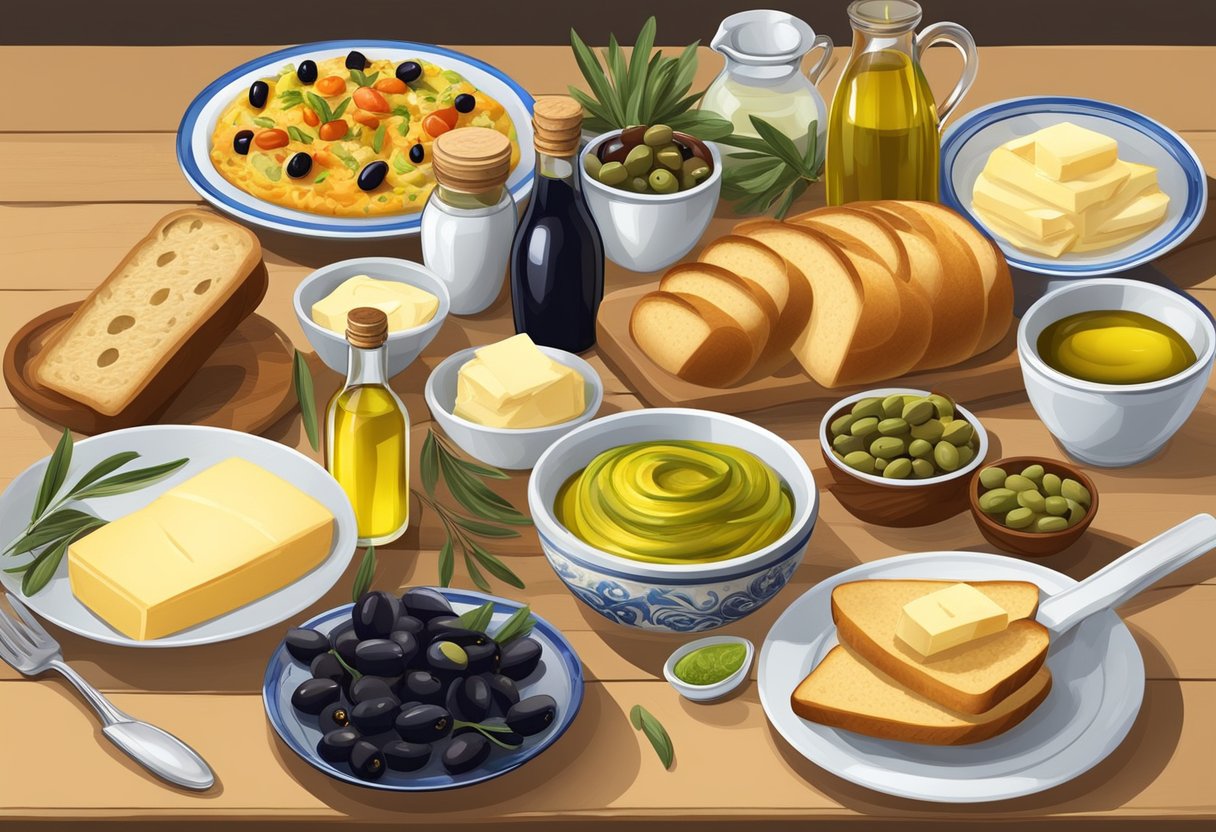Embracing a gluten-free Mediterranean diet presents a delicious journey into the heart of healthy eating. This diet emphasizes the consumption of fresh fruits, lean proteins, and particularly heart-healthy fats. When it comes to fats, butter and margarine often come to the forefront of dietary considerations. Both can coexist within a gluten-free Mediterranean diet, but understanding their roles and health implications is crucial for maintaining both the essence of the diet and gluten-free integrity.

The Mediterranean diet is traditionally rich in healthy fats, with a frequent use of olive oil as its cornerstone. However, the inclusion of dairy products like butter, which is naturally gluten-free, can add richness to the diet while still adhering to gluten-free needs. Margarine, alternatively, offers a different set of advantages and potential drawbacks, depending on its formulation. For individuals with celiac disease or gluten sensitivity, ensuring that margarine is free from gluten-containing additives is essential. As part of a gluten-free Mediterranean lifestyle, deciphering labels and choosing high-quality fats contribute to the success and health benefits of the diet.
Key Takeaways
- Butter is a compatible choice for a gluten-free Mediterranean diet when used in moderation.
- Margarine must be carefully selected to avoid gluten-containing additives.
- Understanding the quality and composition of fats is important within a gluten-free Mediterranean lifestyle.
Table of Contents
Understanding Gluten and Celiac Disease
In the context of a gluten-free Mediterranean diet, it’s essential to understand what gluten is, the nature of celiac disease, and how gluten sensitivities and intolerances can affect individuals.
What Is Gluten?
Gluten is a group of proteins found in certain grains, such as wheat, barley, and rye. It gives dough its elasticity, helping it to rise and maintain its shape, and often gives the final product a chewy texture. For those on a gluten-free diet, avoiding gluten is crucial since even small amounts can cause health issues for individuals with gluten-related disorders.
Overview of Celiac Disease
Celiac disease is an autoimmune disorder triggered by gluten ingestion in genetically predisposed individuals. This condition leads to the inflammation and damage of the small intestine’s lining, impairing nutrient absorption. A strict, lifelong gluten-free diet is the only existing treatment to manage celiac disease and prevent related complications.
Gluten Sensitivities and Intolerances
Apart from celiac disease, people can have non-celiac gluten sensitivity or gluten intolerance, presenting similar, but typically less severe, symptoms without the intestinal damage. These individuals often experience an array of symptoms, including bloating, headaches, or fatigue after consuming gluten and may benefit from a gluten-free diet.
Basics of the Mediterranean Diet

The Mediterranean Diet emphasizes a diverse and nutrient-rich intake primarily consisting of plant-based foods and healthy fats, with a focus on both heart health and overall well-being.
Core Components and Foods
At the heart of the Mediterranean Diet are core constituents that promote a balanced and healthy eating pattern. The diet is structured around:
- Fruits and Vegetables: A plentiful variety of fresh or minimally processed items, providing vitamins, minerals, and fiber.
- Whole Grains: Gluten-free options, such as quinoa or brown rice, offer necessary nutrients and help to maintain a balanced diet.
- Nuts and Seeds: A source of protein, healthy fats, and fiber, to be consumed in moderation.
- Olive Oil: A staple fat source, rich in monounsaturated fats and known for its heart-healthy effects.
- Fish and Seafood: Preferred over red meats, these are high in omega-3 fatty acids and serve as a primary protein source.
- Poultry: Chicken and turkey often replace higher-fat meats and provide high-quality protein.
- Eggs: Included for protein but advised in moderation.
- Dairy: Low-fat and fermented options like yogurt and cheese contribute protein and calcium.
- Wine: Often included in moderation due to potential health benefits linked to moderate consumption.
- Water: Essential for hydration and often the preferred beverage alongside meals.
Health Benefits of the Mediterranean Diet
The Mediterranean Diet is associated with:
- Reduced risk of heart disease and cardiovascular disease due to a high intake of healthy fats and a balanced profile of macro and micronutrients.
- Support in managing blood pressure, type 2 diabetes, and cholesterol levels, attributed to the diet’s nutrient-rich profile and emphasis on fiber and whole foods.
- Presence of essential vitamins and minerals that promote overall health, alongside consistent hydration from water which is crucial for all bodily functions.
Adapting the Mediterranean Diet to Gluten-Free Needs

When adapting the Mediterranean diet for gluten-free requirements, the primary focus is on substituting typical whole grains with gluten-free alternatives while maintaining the diet’s rich nutrient profile and ensuring adequate fiber intake.
Gluten-Free Whole Grains and Alternatives
The Mediterranean diet typically includes whole grains, which often contain gluten. For a gluten-free adaptation, these grains must be replaced with gluten-free options that still align with the diet’s principles. Grains such as corn, rice, quinoa, and buckwheat do not contain gluten and can be used as substitutes. These gluten-free whole grains support the same variety and nutritional balance as traditional whole grains.
- Corn: Versatile and can be enjoyed as on-the-cob, popcorn, or polenta.
- Rice: A staple that pairs well with legume and vegetable dishes.
- Quinoa: A complete protein source that also provides fiber.
- Buckwheat: Despite its name, it’s unrelated to wheat and is suitable for gluten-free diet plans.
Maintaining Nutrient Intake on a Gluten-Free Diet
A significant part of healthy eating within the Mediterranean diet includes consuming a variety of nutrients from beans, legumes, vegetables, fruits, nuts, and seeds. It’s important for individuals on a gluten-free Mediterranean diet to ensure they are not missing out on essential nutrients, especially fiber, which is often less abundant in gluten-free diets.
- Beans and Legumes: Important for protein and fiber.
- Vegetables: Provide essential vitamins and minerals.
- Nuts and Seeds: Offer healthy fats along with protein and fiber.
Dietitians recommend focusing on incorporating a diversity of these foods to meet nutritional needs without using gluten-containing products.
Creating a Gluten-Free Mediterranean Meal Plan
Designing a meal plan that caters to gluten-free Mediterranean eating habits involves careful planning to maintain the health benefits of the traditional diet. Such a meal plan should highlight fresh produce, lean proteins, and gluten-free grains, among other components. Consulting a registered dietitian can provide personalized guidance in creating balanced meal plans and offering nutritionally equivalent alternatives. For example:
- Breakfast: Greek yogurt with honey, mixed berries, and a sprinkle of gluten-free granola.
- Lunch: Salad with mixed greens, chickpeas, olives, tomatoes, feta cheese, and a quinoa side.
- Dinner: Grilled fish with a side of roasted vegetables and a serving of buckwheat tabbouleh.
Deconstructing Fats: Butter Vs. Margarine

In the context of a gluten-free Mediterranean diet, fats play an essential role. Understanding the difference between butter and margarine is vital for making informed decisions about fat consumption.
The Role of Fats in the Mediterranean Diet
The Mediterranean diet emphasizes the importance of healthy fats, which are paramount for both taste and nutrition. It primarily includes fats from plant sources like olive oil, which is lauded for its high content of monounsaturated fats. These fats are crucial because they support heart health when used in moderation.
Analyzing Butter and Margarine
Butter, a traditional fat, is derived from animal milk and contains a higher proportion of saturated fat. While flavorful, its saturated fat content is something individuals on a Mediterranean diet monitor closely due to its potential impact on cholesterol levels. Conversely, margarine is a processed product made from various plant oils and was originally created as a butter substitute. Modern margarine varieties have reduced trans fats, which were initially a health concern, and frequently provide essential fatty acids.
Selecting Healthy Fat Sources
When following a gluten-free Mediterranean diet, one should select fat sources that align with the diet’s principles of heart health and overall wellness. In place of butter, health-conscious individuals often opt for margarine brands that are free of trans fats and rich in unsaturated fats. However, the cornerstone of fat selection in this diet is invariably olive oil, due to its abundant monounsaturated fat content and proven health benefits.
Incorporating Butter and Margarine into Gluten-Free Recipes
When adapting to a gluten-free Mediterranean diet, understanding how to use butter and margarine in cooking is key to maintaining rich flavors while adhering to dietary restrictions.
Butter and Margarine in Gluten-Free Cooking
Butter is a staple of the Mediterranean diet, providing a source of healthy fats and adding richness to dishes. On a gluten-free diet, one can confidently use butter as it is naturally gluten-free, complementing other ingredients like herbs and spices without the worry of gluten contamination. As for margarine, individuals need to carefully select varieties that are labeled gluten-free due to the potential presence of additives. Brands like Fleischmann’s offer gluten-free margarine options that can be safely incorporated into gluten-free recipes. These substitutes not only contribute to the desired consistency but can also bolster flavor when combined with ingredients typical of the Mediterranean palate.
Recipe Ideas and Modifications
A gluten-free Mediterranean diet promotes the use of fresh, unprocessed foods and includes an array of recipes where butter and margarine can be integrated seamlessly. For instance, one can prepare gluten-free butter cookies using almond flour, highlighting a classic Mediterranean ingredient while ensuring the treat remains gluten-free. The recipe, found on Land O’Lakes, is adaptable with a gluten-free flour mix and can be customized with various toppings such as nuts or seeds. As for savory dishes, sautéing vegetables in margarine or butter, with a dash of oregano and basil, maintains the integrity of Mediterranean flavors. When modifying traditional recipes, replacing regular flour with gluten-free alternatives and using gluten-free versions of butter or margarine is essential. Moreover, resting the gluten-free dough for at least 30 minutes before baking, as suggested by Food Republic, can improve the texture of cookies and other baked goods.
Challenges and Solutions for a Gluten-Free Mediterranean Lifestyle

Adapting to a gluten-free Mediterranean diet presents unique challenges, particularly concerning ensuring food safety and finding suitable products. The following subsections delve into practical approaches to manage these aspects effectively.
Addressing Cross-Contamination Concerns
Cross-contamination is a critical issue for individuals with celiac disease or gluten sensitivity. The Mediterranean diet often includes breads, pastas, and other dishes that traditionally contain gluten. To address this, strict kitchen protocols need to be adopted. Using separate cooking and preparation areas along with dedicated utensils can significantly reduce the risk of cross-contamination.
Key tips include:
- Storage: Keep gluten-free products in separate, clearly labeled containers.
- Preparation: Use separate chopping boards and knives for gluten-free food preparation.
Finding Gluten-Free Mediterranean Products
While the Mediterranean diet emphasizes fresh fruits, vegetables, and lean proteins, finding gluten-free alternatives for staple items like whole-wheat pastas and breads can be challenging. Look for products certified by the Celiac Disease Foundation or similar organizations to ensure they meet strict gluten-free standards.
Solutions for common products:
- Breads and Crackers: Opt for those made with almond or coconut flour.
- Pasta: Substitute regular pasta with those made from rice or legumes.
Gluten-Free Labeling and Food Safety
Understanding labels is crucial when following a gluten-free Mediterranean diet. The FDA requires that gluten-free products contain less than 20 ppm (parts per million) of gluten. Always read labels carefully to avoid products with wheat, barley, rye, or any derivatives. Be cautious of items like soy sauces and salad dressings, which often contain hidden gluten.
Look for:
- Labels: Products labeled as ‘gluten-free,’ ‘free of gluten,’ ‘no gluten,’ or ‘without gluten.’
- Ingredients: Avoid anything with malt, malt flavoring, or wheat starch.
By being vigilant about cross-contamination, seeking out certified gluten-free Mediterranean products, and fully understanding food labeling, those on a gluten-free Mediterranean diet can navigate the challenges and enjoy a diverse and healthful diet.
Support and Resources for Gluten-Free Mediterranean Dieters
Embarking on a gluten-free Mediterranean diet requires access to the right support networks and professional advice to maintain a healthy eating pattern. These resources are crucial for individuals with celiac disease, gluten sensitivities, or other chronic conditions.
Community Support and Education
Those following a gluten-free Mediterranean diet can benefit from community support groups and educational resources provided by organizations such as the Celiac Disease Foundation. They offer advice on managing a gluten-free lifestyle while ensuring nutritional adequacy to prevent complications like anemia and to bolster overall health. Education on incorporating whole foods like fruits, vegetables, legumes, and lean proteins makes the heart of the community support.
Professional Guidance and Consultation
For personalized dietary planning and to navigate the challenges of celiac disease, consulting a registered dietitian with experience in gluten-free diets is invaluable. They can tailor advice to prevent cross-contamination, ensuring a diet rich in nutrients, and reducing the risks associated with chronic conditions. Feedback from certified professionals contributes to a robust, gluten-free lifestyle, reinforcing healthy eating patterns.
Discussion on Grains and Dairy in the Gluten-Free Mediterranean Diet

In a gluten-free Mediterranean diet, the choice of grains and dairy directly relates to nutritional balance and health outcomes. Selecting non-gluten grains and appropriate dairy options is crucial for nutritional adequacy and diet enjoyment.
Non-Gluten Grains and Their Nutritional Profiles
Grains are a staple in the Mediterranean diet; however, traditional grains like wheat, barley, and rye contain gluten, which must be avoided in a gluten-free diet. Gluten-free grains such as oats, corn, and rice become important alternatives. Oats are inherently gluten-free but are often contaminated with gluten; hence, one should ensure that the oats are certified gluten-free. They provide a good source of iron and are noted for their beneficial fiber content.
Corn is another gluten-free grain high in fiber and B vitamins. Whole-grain corn products add variety and nutrition without the gluten found in other staple grains. Rice, a versatile and widely consumed gluten-free option, comes in numerous varieties, each with a unique nutritional profile. Brown rice, for example, retains more nutrients like B vitamins and iron than its white counterpart.
Non-Gluten Grains:
- Oats: Rich in fiber, iron.
- Corn: High in fiber, B vitamins.
- Rice: Good source of B vitamins; brown rice is richer in nutrients.
These grains fit well into the gluten-free Mediterranean diet, providing necessary carbohydrates and nutrients with the assuredness of being gluten-free.
Dairy and Non-Dairy Options in the Diet
When it comes to dairy, this diet allows moderate consumption of dairy products like yogurt and cheese. Dairy options are a good source of calcium and other essential nutrients, supporting bone health and providing protein. In the context of the Mediterranean diet, the emphasis is on low-fat and fermented dairy products, like Greek yogurt, which offer digestive benefits and are often easier for some to digest.
For individuals on a gluten-free Mediterranean diet who cannot tolerate dairy or prefer to avoid it, non-dairy alternatives fortified with calcium and other nutrients are available. Almond milk, soy milk, and coconut yogurt are examples of non-dairy products that can provide nutritional benefits similar to dairy while also fitting within the dietary restrictions.
Dairy and Non-Dairy Options:
- Yogurt: Preferably low-fat or fat-free; source of protein and calcium.
- Cheese: In moderation; offers calcium.
- Non-Dairy Alternatives: Often fortified with calcium; include almond milk, soy milk.
It is essential to ensure that both dairy and non-dairy options are free from gluten-containing ingredients or cross-contamination to maintain a strictly gluten-free diet.
Conclusion

Adhering to a gluten-free Mediterranean diet serves as a robust foundation for healthy eating. Individuals with gluten sensitivity or celiac disease can benefit from incorporating gluten-free alternatives into the traditional Mediterranean dietary pattern, which emphasizes the consumption of vegetables, fruits, legumes, and healthy fats like olive oil.
Incorporating gluten-free options, such as a switch from butter to gluten-free margarine, may reduce the risk of chronic conditions. The diet’s focus on heart-healthy fats is linked to a lower incidence of heart disease. The abundant nutrition offered by this diet’s plant-based components further supports overall well-being and may contribute to a reduced risk of cancer and stroke.
It is observed that the diet can be tailored for a gluten-free lifestyle without compromising its inherent health benefits. Those on a gluten-free diet can enjoy versatility through the Mediterranean cuisine’s variety, from seafood to poultry, with the confidence of maintaining their dietary restrictions.
Overall, the gluten-free Mediterranean diet presents a balanced approach to eating that supports the prevention of chronic diseases while catering to those requiring a strict gluten-free diet. It stands as a testament to the possibility of combining health needs and flavorful eating.
Frequently Asked Questions

When adopting a gluten-free Mediterranean diet, individuals often have questions regarding the inclusion of dairy products like butter, alternatives to traditional spreads such as margarine, and how to ensure a balanced approach to meals.
Are dairy products like butter permitted in a gluten-free Mediterranean diet plan?
Dairy products, including butter, generally do not contain gluten and are permitted on a gluten-free Mediterranean diet. It is important, however, to read labels to ensure that there has been no cross-contamination or addition of gluten-containing ingredients.
Which spreads are considered acceptable substitutes for margarine in Mediterranean cuisine?
Alternatives to margarine that align with Mediterranean dietary patterns include olive oil, avocado oil, and other plant-based oils. These provide the benefit of heart-healthy fats without gluten, making them suitable for a gluten-free diet.
How can one adapt traditional Mediterranean recipes to cater to a gluten-free lifestyle?
To make traditional Mediterranean dishes gluten-free, one should substitute gluten-containing ingredients with alternatives such as almond flour or gluten-free whole grains. For example, when a recipe calls for couscous, quinoa can be a gluten-free alternative.
What are the guidelines for including fats in a gluten-free Mediterranean diet?
The gluten-free Mediterranean diet focuses on the consumption of healthy fats, primarily from sources like extra-virgin olive oil, nuts, and seeds. Saturated fats, including those from butter, should be used sparingly.
Can I incorporate gluten-free grains into the Mediterranean diet, and how?
Yes, gluten-free grains such as quinoa, buckwheat, and brown rice can be included in the Mediterranean diet. They can be used as bases for dishes, in salads, or as sides, enriching the diet with fiber and nutrients.
What are the best practices for maintaining a balanced gluten-free Mediterranean meal plan?
To maintain balanced nutrition on this diet, it’s advised to eat a variety of vegetables, fruits, legumes, seafood, and lean poultry. Regular inclusion of gluten-free whole grains and healthy fats is also recommended to support overall health.



